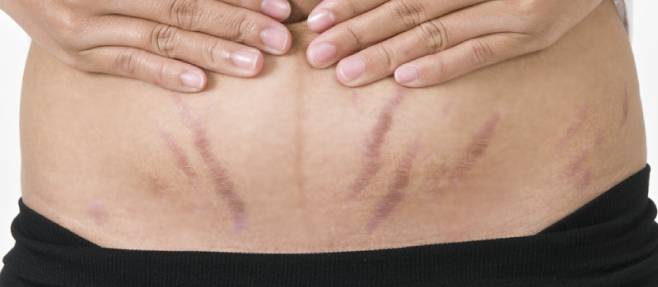Effective Stretch Mark Removal Treatments: What Really Works?

Originally published on July 18, 2014. Updated May 15, 2025 with information on the latest stretch mark treatments.
Stretch marks (also referred to as striae) are a common skin condition that often manifest as stripes with abnormal color and texture. Stretch marks are a natural response by the skin to a rapid expansion of a body mass, commonly seen with obesity or pregnancy. It is estimated that nearly 90% of all pregnant women will develop stretch marks during their pregnancy. Stretch marks are also genetic: if you’re immediate family has a history of stretch marks, it is likely that you are susceptible.
For many men and women, stretch marks can be a source of embarrassment, spurring a huge growth in products and treatments targeting stretch mark removal. We’ll take an in-depth look at stretch marks and discuss which stretch mark removal treatments have been proven to be effective.
What Are Stretch Marks?
Stretch marks appear as streaks, bands or lines on the skin which differ in color from surrounding skin tissue. Sometimes, stretch marks feel ridged or indented. They can also be itchy or painful.
Stretch marks develop when skin quickly stretches or shrinks. This causes rupturing of collagen and elastin, two proteins which give skin its structure. Stretch marks are the scars which result from the healing process.
Not everyone experiences stretch marks with changes to their body weight. Some people are more susceptible to stretch marks than others.
Are There Different Types Of Stretch Marks?
Stretch marks may differ in their causes, color, shape or size. They can also differ depending on where they are on the body. Some are located in one specific area, such as the breasts, while other types are more widespread. Stretch marks are medically classified by color or cause.
Coloring: Stretch marks may be pink, red, purple, blue, dark brown, light brown or grayish in color.
Cause: Some stretch marks are pregnancy-induced, for example, while others are the results of thin skin.
Where Do Stretch Marks Occur?
Stretch marks are typically located on the thighs, buttocks, stomach, breasts, or upper arms. These are the areas where your body is most likely to store fat. As such, these areas are susceptible to rapid changes in size and shape.
What causes stretch marks?
Stretch marks can develop when the dermis (second layer of skin) is stretched over a prolonged period of time, leading to inflammation and subsequent breakdown of collagen fibers. Because of this inflammatory process, blood vessels in the area dilate, giving stretch marks a typical purple or red color early on. After a period of months, the destructive inflammatory process subsides and stretch marks appear white.
When skin rapidly stretches or shrinks, the stress hormone, cortisol, is produced. This hormone results in lost skin elasticity, causing collagen and elastin in the skin to rupture. As skin heals, stretch marks are the resulting scars.
The most common causes for the rapid weight gain and weight loss that leads to stretch marks includes the following:
- Adolescent growth spurts
- Pregnancy
- Rapid weight gain or weight loss due to illness or stress
- Rapid muscle growth with weight training
Medications that include cortisone, a steroid that mimics cortisol, may also lead to stretch marks. In addition, some syndromes and diseases include stretch marks among their symptoms.
Can stretch marks ever fully disappear?
Bright red, very early stretch marks (within a few weeks of developing) may be completely reversible. Unfortunately, many patients seek treatment months to years following their development, after the inflammatory process within the stretch marks has had time to produce irreversible damage. Once stretch marks have turned white, they can be improved but will likely never completely vanish. Any product or treatment promising to completely get rid of white stretch marks should be looked at with skepticism. However, there are treatments that effectively minimize the visual appearance of stretch marks, specifically targeting their color and texture.
Who is Most At Risk for Stretch Marks?
Not everyone who rapidly gains or loses weight develops stretch marks. Genetics play a large role. In addition, you’re more at risk for stretch marks if you were born a woman or if you have light, pale skin.
Can Stretch Marks Be Prevented?
There’s no sure way to prevent stretch marks, but there is evidence some techniques work better than others.
Regularly moisturizing with hyaluronic acid or products containing the herb centella are the most effective preventatives. These methods are even more effective when products are massaged into the skin, used every day, and used early in the formation of stretch marks.
In addition, maintaining a healthy, consistent body weight can prevent stretch marks from forming.
Effective Treatments For Stretch Marks
Stretch marks frequently go away on their own over time. If they don’t, or if your stretch marks are painful or itchy, you may want to consider treatment. The following treatment options have been effective in some, but not all patients.
Tretinoin Cream
Tretinoin is a retinol which works by restoring skin’s collagen. This treatment works best when used on new stretch marks that are still pink or red. It may cause skin irritation in some people, and should never be used by pregnant women.
Fraxel Laser
Laser treatments heal stretch marks by improving blood flow to the area and stimulating collagen and elastin production. Fraxel, or fractional photothermolysis, uses a laser to heat the skin, triggering a healing response.
Pulsed Dye Laser
Pulsed dye laser therapy works best on light skin and new stretch marks. This treatment is less intense than Fraxel and may be more effective in treating discoloration due to stretch marks.
Microdermabrasion
Microdermabrasion may help minimize the appearance of older stretch marks. This treatment uses microcrystals to create an even layer of skin damage, which then heals as smoother and more evenly toned.
Microneedling
Microneedling also triggers a skin healing response, but does so by damaging the top layer of skin with several pricks of tiny needles. This technique is safer to use in skin color compared to some lasers
Chemical Peels
Chemical peels can be applied in varying degrees of intensity, but all work by chemically exfoliating the top layers of skin. Newer skin cells which are smoother and even replace the shed layers.
The above stretch mark treatments each require multiple visits, which steadily decreases the appearance of stretch marks over time. Your dermatologist may recommend using more than one treatment method as part of a comprehensive, stretch-mark treatment protocol.
It’s possible that your stretch marks can be minimized, but like other scars, never permanently removed. A consultation with a board-certified dermatologist can help you understand which treatment options are best for you.
Disclaimer: The contents of the Westlake Dermatology website, including text, graphics, and images, are for informational purposes only and are not intended to substitute for direct medical advice from your physician or other qualified professional.

Thanks for sharing this information on stretch marks. My wife after pregnancy has stretch marks, and wants a plastic surgeon to remove them. She doesn’t know much about procedures regarding stretch marks, though, so I will send this to her. Thanks again for sharing!
I am interested in the research study for stretch marks if still available
Hi there, I really enjoyed this article. I wanted to
write a little comment to support you!
Nice post 🙂
Thank for your support Tim!
Very informative! Thanks for sharing. In my experience, I’ve used laser treatment and Microdermabrasion to get rid of my old and big stretch marks. For those new ones however, I got rid rid of them just by using some home remedies and natural oils.
What all did you use?
I have developed really bad stretch marks from m pregnancy and my whole belly has turned dark. I started using dermelastic Serum a month back and have seen good progress so far. My stretch marks around my naval area seem to have lightened a bit. I will continue to use this product.
Awesome Erika, glad to hear you are experiencing good results with that product!
I hate my stretch marks!!!!!
I was rather overweight a few years back and have since dieted down to a normal BMI, however, I now find myself having a normal body that is full of scars and marks! For three weeks, I have been using the Somaluxe Firming Lotion and I still have some left but I found that my stretch marks are less red. I hope if I keep using it longer they will dissappear !
Hi Beau, thanks for reading and submitting your comment. Also congratulations on getting to a normal BMI. Please let us know how the firming lotion works!
My stretch marks are the worst because they’re very long and purple. I’m hopeful that when I lose more weight around my tummy that they’ll become less noticeable, but knowing me and my luck, it probably won’t happen.
I’ve been trying some creams for my stretch marks but did not get good results. What can I do?
Hi Paula,
Thanks for reading our post! Unfortunately most stretch mark removal creams are ineffective. Laser treatments are definitely one of the most effective means of treating stretch marks. Please call us to schedule an appointment and we can find the best laser treatment for your specific needs!
Thanks,
WD Staff
I had a few stretch marks on the side of my belly at 20 weeks of pregnancy, I immediately started using dermelastic serum and the marks disappeared a few weeks later, I am 35 weeks now and so far no stretch marks.
I gained a lot of weight this year and dermelastic serum got rid of ALL my red stretch marks that were new. I rubbed it on my thighs, hips and chest, every night after my shower. The smell is a tiny bit musky but it’s not bad and fades. It doesn’t stain clothes or sheets. I noticed a difference after about 3-4 weeks of use.
I wanted to ask about pricing for stretchmark treatment please.
Irene
Hi Irene,
Thanks for reading our post and for your interest! The cost for treatment will depend on the treatment area (size) and characteristics like severity. So unfortunately the only way to quote a price is through an in-person consultation. If you are in the Austin area, please give us a call to setup a consult!
Thanks,
WD Staff
hate stretchmarks 🙁
If you are pregnant, Dermalmd stretch mark removal serum is your go to! I am 6 months pregnant and have been using this twice a day since 5 weeks, and so far no stretch marks. It feels great on your skin and does not stain or leave an oily residue on your clothes.
The creams and simple tricks DO NOT WORK. Thinking about laser and this really helped me make sense of everything. Thanks for sharing